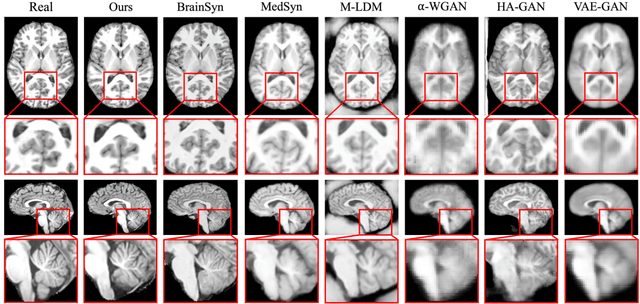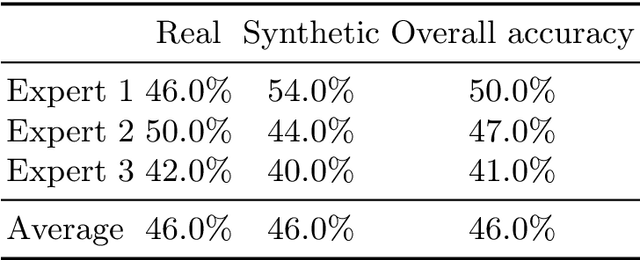Image To Image Translation
Image-to-image translation is the process of converting an image from one domain to another using deep learning techniques.
Papers and Code
Integrating Anatomical Priors into a Causal Diffusion Model
Sep 10, 2025



3D brain MRI studies often examine subtle morphometric differences between cohorts that are hard to detect visually. Given the high cost of MRI acquisition, these studies could greatly benefit from image syntheses, particularly counterfactual image generation, as seen in other domains, such as computer vision. However, counterfactual models struggle to produce anatomically plausible MRIs due to the lack of explicit inductive biases to preserve fine-grained anatomical details. This shortcoming arises from the training of the models aiming to optimize for the overall appearance of the images (e.g., via cross-entropy) rather than preserving subtle, yet medically relevant, local variations across subjects. To preserve subtle variations, we propose to explicitly integrate anatomical constraints on a voxel-level as prior into a generative diffusion framework. Called Probabilistic Causal Graph Model (PCGM), the approach captures anatomical constraints via a probabilistic graph module and translates those constraints into spatial binary masks of regions where subtle variations occur. The masks (encoded by a 3D extension of ControlNet) constrain a novel counterfactual denoising UNet, whose encodings are then transferred into high-quality brain MRIs via our 3D diffusion decoder. Extensive experiments on multiple datasets demonstrate that PCGM generates structural brain MRIs of higher quality than several baseline approaches. Furthermore, we show for the first time that brain measurements extracted from counterfactuals (generated by PCGM) replicate the subtle effects of a disease on cortical brain regions previously reported in the neuroscience literature. This achievement is an important milestone in the use of synthetic MRIs in studies investigating subtle morphological differences.
Sample-Aware Test-Time Adaptation for Medical Image-to-Image Translation
Aug 01, 2025Image-to-image translation has emerged as a powerful technique in medical imaging, enabling tasks such as image denoising and cross-modality conversion. However, it suffers from limitations in handling out-of-distribution samples without causing performance degradation. To address this limitation, we propose a novel Test-Time Adaptation (TTA) framework that dynamically adjusts the translation process based on the characteristics of each test sample. Our method introduces a Reconstruction Module to quantify the domain shift and a Dynamic Adaptation Block that selectively modifies the internal features of a pretrained translation model to mitigate the shift without compromising the performance on in-distribution samples that do not require adaptation. We evaluate our approach on two medical image-to-image translation tasks: low-dose CT denoising and T1 to T2 MRI translation, showing consistent improvements over both the baseline translation model without TTA and prior TTA methods. Our analysis highlights the limitations of the state-of-the-art that uniformly apply the adaptation to both out-of-distribution and in-distribution samples, demonstrating that dynamic, sample-specific adjustment offers a promising path to improve model resilience in real-world scenarios. The code is available at: https://github.com/cosbidev/Sample-Aware_TTA.
MANGO: Multimodal Attention-based Normalizing Flow Approach to Fusion Learning
Aug 13, 2025Multimodal learning has gained much success in recent years. However, current multimodal fusion methods adopt the attention mechanism of Transformers to implicitly learn the underlying correlation of multimodal features. As a result, the multimodal model cannot capture the essential features of each modality, making it difficult to comprehend complex structures and correlations of multimodal inputs. This paper introduces a novel Multimodal Attention-based Normalizing Flow (MANGO) approach\footnote{The source code of this work will be publicly available.} to developing explicit, interpretable, and tractable multimodal fusion learning. In particular, we propose a new Invertible Cross-Attention (ICA) layer to develop the Normalizing Flow-based Model for multimodal data. To efficiently capture the complex, underlying correlations in multimodal data in our proposed invertible cross-attention layer, we propose three new cross-attention mechanisms: Modality-to-Modality Cross-Attention (MMCA), Inter-Modality Cross-Attention (IMCA), and Learnable Inter-Modality Cross-Attention (LICA). Finally, we introduce a new Multimodal Attention-based Normalizing Flow to enable the scalability of our proposed method to high-dimensional multimodal data. Our experimental results on three different multimodal learning tasks, i.e., semantic segmentation, image-to-image translation, and movie genre classification, have illustrated the state-of-the-art (SoTA) performance of the proposed approach.
Bangla-Bayanno: A 52K-Pair Bengali Visual Question Answering Dataset with LLM-Assisted Translation Refinement
Aug 27, 2025



In this paper, we introduce Bangla-Bayanno, an open-ended Visual Question Answering (VQA) Dataset in Bangla, a widely used, low-resource language in multimodal AI research. The majority of existing datasets are either manually annotated with an emphasis on a specific domain, query type, or answer type or are constrained by niche answer formats. In order to mitigate human-induced errors and guarantee lucidity, we implemented a multilingual LLM-assisted translation refinement pipeline. This dataset overcomes the issues of low-quality translations from multilingual sources. The dataset comprises 52,650 question-answer pairs across 4750+ images. Questions are classified into three distinct answer types: nominal (short descriptive), quantitative (numeric), and polar (yes/no). Bangla-Bayanno provides the most comprehensive open-source, high-quality VQA benchmark in Bangla, aiming to advance research in low-resource multimodal learning and facilitate the development of more inclusive AI systems.
MM2CT: MR-to-CT translation for multi-modal image fusion with mamba
Aug 07, 2025Magnetic resonance (MR)-to-computed tomography (CT) translation offers significant advantages, including the elimination of radiation exposure associated with CT scans and the mitigation of imaging artifacts caused by patient motion. The existing approaches are based on single-modality MR-to-CT translation, with limited research exploring multimodal fusion. To address this limitation, we introduce Multi-modal MR to CT (MM2CT) translation method by leveraging multimodal T1- and T2-weighted MRI data, an innovative Mamba-based framework for multi-modal medical image synthesis. Mamba effectively overcomes the limited local receptive field in CNNs and the high computational complexity issues in Transformers. MM2CT leverages this advantage to maintain long-range dependencies modeling capabilities while achieving multi-modal MR feature integration. Additionally, we incorporate a dynamic local convolution module and a dynamic enhancement module to improve MRI-to-CT synthesis. The experiments on a public pelvis dataset demonstrate that MM2CT achieves state-of-the-art performance in terms of Structural Similarity Index Measure (SSIM) and Peak Signal-to-Noise Ratio (PSNR). Our code is publicly available at https://github.com/Gots-ch/MM2CT.
On the Utility of Virtual Staining for Downstream Applications as it relates to Task Network Capacity
Jul 31, 2025Virtual staining, or in-silico-labeling, has been proposed to computationally generate synthetic fluorescence images from label-free images by use of deep learning-based image-to-image translation networks. In most reported studies, virtually stained images have been assessed only using traditional image quality measures such as structural similarity or signal-to-noise ratio. However, in biomedical imaging, images are typically acquired to facilitate an image-based inference, which we refer to as a downstream biological or clinical task. This study systematically investigates the utility of virtual staining for facilitating clinically relevant downstream tasks (like segmentation or classification) with consideration of the capacity of the deep neural networks employed to perform the tasks. Comprehensive empirical evaluations were conducted using biological datasets, assessing task performance by use of label-free, virtually stained, and ground truth fluorescence images. The results demonstrated that the utility of virtual staining is largely dependent on the ability of the segmentation or classification task network to extract meaningful task-relevant information, which is related to the concept of network capacity. Examples are provided in which virtual staining does not improve, or even degrades, segmentation or classification performance when the capacity of the associated task network is sufficiently large. The results demonstrate that task network capacity should be considered when deciding whether to perform virtual staining.
Translation of Text Embedding via Delta Vector to Suppress Strongly Entangled Content in Text-to-Image Diffusion Models
Aug 14, 2025Text-to-Image (T2I) diffusion models have made significant progress in generating diverse high-quality images from textual prompts. However, these models still face challenges in suppressing content that is strongly entangled with specific words. For example, when generating an image of ``Charlie Chaplin", a ``mustache" consistently appears even if explicitly instructed not to include it, as the concept of ``mustache" is strongly entangled with ``Charlie Chaplin". To address this issue, we propose a novel approach to directly suppress such entangled content within the text embedding space of diffusion models. Our method introduces a delta vector that modifies the text embedding to weaken the influence of undesired content in the generated image, and we further demonstrate that this delta vector can be easily obtained through a zero-shot approach. Furthermore, we propose a Selective Suppression with Delta Vector (SSDV) method to adapt delta vector into the cross-attention mechanism, enabling more effective suppression of unwanted content in regions where it would otherwise be generated. Additionally, we enabled more precise suppression in personalized T2I models by optimizing delta vector, which previous baselines were unable to achieve. Extensive experimental results demonstrate that our approach significantly outperforms existing methods, both in terms of quantitative and qualitative metrics.
CTA-Flux: Integrating Chinese Cultural Semantics into High-Quality English Text-to-Image Communities
Aug 20, 2025We proposed the Chinese Text Adapter-Flux (CTA-Flux). An adaptation method fits the Chinese text inputs to Flux, a powerful text-to-image (TTI) generative model initially trained on the English corpus. Despite the notable image generation ability conditioned on English text inputs, Flux performs poorly when processing non-English prompts, particularly due to linguistic and cultural biases inherent in predominantly English-centric training datasets. Existing approaches, such as translating non-English prompts into English or finetuning models for bilingual mappings, inadequately address culturally specific semantics, compromising image authenticity and quality. To address this issue, we introduce a novel method to bridge Chinese semantic understanding with compatibility in English-centric TTI model communities. Existing approaches relying on ControlNet-like architectures typically require a massive parameter scale and lack direct control over Chinese semantics. In comparison, CTA-flux leverages MultiModal Diffusion Transformer (MMDiT) to control the Flux backbone directly, significantly reducing the number of parameters while enhancing the model's understanding of Chinese semantics. This integration significantly improves the generation quality and cultural authenticity without extensive retraining of the entire model, thus maintaining compatibility with existing text-to-image plugins such as LoRA, IP-Adapter, and ControlNet. Empirical evaluations demonstrate that CTA-flux supports Chinese and English prompts and achieves superior image generation quality, visual realism, and faithful depiction of Chinese semantics.
No Masks Needed: Explainable AI for Deriving Segmentation from Classification
Aug 06, 2025Medical image segmentation is vital for modern healthcare and is a key element of computer-aided diagnosis. While recent advancements in computer vision have explored unsupervised segmentation using pre-trained models, these methods have not been translated well to the medical imaging domain. In this work, we introduce a novel approach that fine-tunes pre-trained models specifically for medical images, achieving accurate segmentation with extensive processing. Our method integrates Explainable AI to generate relevance scores, enhancing the segmentation process. Unlike traditional methods that excel in standard benchmarks but falter in medical applications, our approach achieves improved results on datasets like CBIS-DDSM, NuInsSeg and Kvasir-SEG.
You Only Pose Once: A Minimalist's Detection Transformer for Monocular RGB Category-level 9D Multi-Object Pose Estimation
Aug 20, 2025Accurately recovering the full 9-DoF pose of unseen instances within specific categories from a single RGB image remains a core challenge for robotics and automation. Most existing solutions still rely on pseudo-depth, CAD models, or multi-stage cascades that separate 2D detection from pose estimation. Motivated by the need for a simpler, RGB-only alternative that learns directly at the category level, we revisit a longstanding question: Can object detection and 9-DoF pose estimation be unified with high performance, without any additional data? We show that they can with our method, YOPO, a single-stage, query-based framework that treats category-level 9-DoF estimation as a natural extension of 2D detection. YOPO augments a transformer detector with a lightweight pose head, a bounding-box-conditioned translation module, and a 6D-aware Hungarian matching cost. The model is trained end-to-end only with RGB images and category-level pose labels. Despite its minimalist design, YOPO sets a new state of the art on three benchmarks. On the REAL275 dataset, it achieves 79.6% $\rm{IoU}_{50}$ and 54.1% under the $10^\circ$$10{\rm{cm}}$ metric, surpassing prior RGB-only methods and closing much of the gap to RGB-D systems. The code, models, and additional qualitative results can be found on our project.
 Add to Chrome
Add to Chrome Add to Firefox
Add to Firefox Add to Edge
Add to Edge